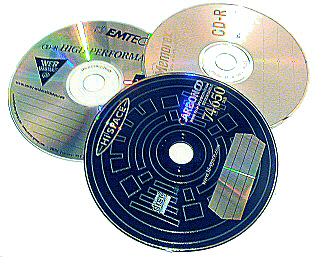|
Finalize (optical Discs)
Finalizing (also spelled finalising) an optical disc is the process of writing out support data such as DVD menus, directory data, and the like to an optical disc in order to make it playable on a system other than the one it was recorded on. As a general rule, finalization means that the disc cannot have any additional data written to it. It is the last step in the DVD authoring process. The term is also used as an alternative word for the "closing" of a CD-R, in which Table of Contents data and the like are written out to enable the computer to read a CD. Like DVD finalization, a closed CD-R cannot receive any additional data. Some recording formats, such as DVD+VR The DVD (common abbreviation for Digital Video Disc or Digital Versatile Disc) is a digital optical disc data storage format. It was invented and developed in 1995 and first released on November 1, 1996, in Japan. The medium can store any ki ..., do not require finalization before they can be played. Opti ... [...More Info...] [...Related Items...] OR: [Wikipedia] [Google] [Baidu] |
DVD Authoring
DVD authoring is the process of creating a DVD video capable of playing on a DVD player. DVD authoring software must conform to the specifications set by the DVD Forum. DVD authoring is the second step in the process of producing finished DVDs. The first step is the creation of the movie (or programme) and the second, the authoring, is the creation of artwork, user menus, insertion of chapter points, overdubs/commentaries, setting autoplay and/or repeat options, etc. The final step is the manufacturing (replication) process to mass-produce finished DVDs. Strictly speaking, DVD authoring differs from the process of Moving Picture Experts Group, MPEG encoding, but most DVD authoring software has a built-in encoder, although separate encoders are still used when better quality or finer control over compression settings are required. Most DVD-authoring applications focus exclusively on video DVDs and do not support the authoring of DVD-Audio discs. Stand-alone DVD recorder units ... [...More Info...] [...Related Items...] OR: [Wikipedia] [Google] [Baidu] |
CD-R
CD-R (Compact disc-recordable) is a digital optical disc storage format. A CD-R disc is a compact disc that can be written once and read arbitrarily many times. CD-R discs (CD-Rs) are readable by most CD readers manufactured prior to the introduction of CD-R, unlike CD-RW discs. History Originally named CD Write-Once (WO), the CD-R specification was first published in 1988 by Philips and Sony in the Orange Book, which consists of several parts that provide details of the CD-WO, CD-MO (Magneto-Optic), and later CD-RW (ReWritable). The latest editions have abandoned the use of the term "CD-WO" in favor of "CD-R", while "CD-MO" was rarely used. Written CD-Rs and CD-RWs are, in the aspect of low-level encoding and data format, fully compatible with the audio CD (''Red Book'' CD-DA) and data CD (''Yellow Book'' CD-ROM) standards. The Yellow Book standard for CD-ROM only specifies a high-level data format and refers to the Red Book for all physical format and low-level code de ... [...More Info...] [...Related Items...] OR: [Wikipedia] [Google] [Baidu] |
TOC (CD)
Optical disc authoring, including DVD and Blu-ray Disc authoring, is the process of assembling source material—video, audio or other data—into the proper logical volume format to then be recorded ("burned") onto an optical disc (typically a compact disc or DVD). Process To burn an optical disc, one usually first creates an optical disc image with a full file system, of a type designed for the optical disc, in temporary storage such as a file in another file system on a disk drive. One may test the image on target devices using rewriteable media such as CD-RW, DVD±RW and BD-RE. Then, one copies the image to the disc (usually write-once media for hard distribution). Most optical disc authoring utilities create a disc image and copy it to the disc in one bundled operation, so that end-users often do not know the distinction between creating and burning. However, it is useful to know because creating the disc image is a time-consuming process, while copying the imag ... [...More Info...] [...Related Items...] OR: [Wikipedia] [Google] [Baidu] |
DVD+VR
The DVD (common abbreviation for Digital Video Disc or Digital Versatile Disc) is a digital optical disc data storage format. It was invented and developed in 1995 and first released on November 1, 1996, in Japan. The medium can store any kind of digital data and has been widely used for video programs (watched using DVD players) or formerly for storing software and other computer files as well. DVDs offer significantly higher storage capacity than compact discs (CD) while having the same dimensions. A standard DVD can store up to 4.7 GB of storage, while variants can store up to a maximum of 17.08 GB. Prerecorded DVDs are mass-produced using molding machines that physically stamp data onto the DVD. Such discs are a form of DVD-ROM because data can only be read and not written or erased. Blank recordable DVD discs (DVD-R and DVD+R) can be recorded once using a DVD recorder and then function as a DVD-ROM. Rewritable DVDs (DVD-RW, DVD+RW, and DVD-RAM) can be recorded and er ... [...More Info...] [...Related Items...] OR: [Wikipedia] [Google] [Baidu] |
